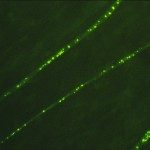Lien vers Pubmed [PMID] – 18453596
J. Immunol. 2008 May;180(10):6760-7
West Nile virus (WNV) is an emerging neurotropic flavivirus. We investigated the dynamics of immune cell recruitment in peripheral tissues and in the CNS during WNV encephalitis in an immunocompetent mouse model. In the periphery, immune cell expansion can successfully limit viremia and lymphoid tissue infection. However, viral clearance in the periphery is too late to prevent viral invasion of the CNS. In the CNS, innate immune cells, including microglia/macrophages, NK cells, and plasmacytoid dendritic cells, greatly expand as the virus invades the brain, whereas B and T cells are recruited after viral invasion, and fail to control the spread of the virus. Thus, the onset of WNV encephalitis was correlated both with CNS viral infection and with a large local increase of innate immune cells. Interestingly, we identify a new immune cell type: CD19(+)B220(-) BST-2(+), which we name G8-ICs. These cells appear during peripheral infection and enter the CNS. G8-ICs express high levels of MHC class II, stain for viral Ag, and are localized in the paracortical zone of lymph nodes, strongly suggesting they are previously unidentified APCs that appear in response to viral infection.






